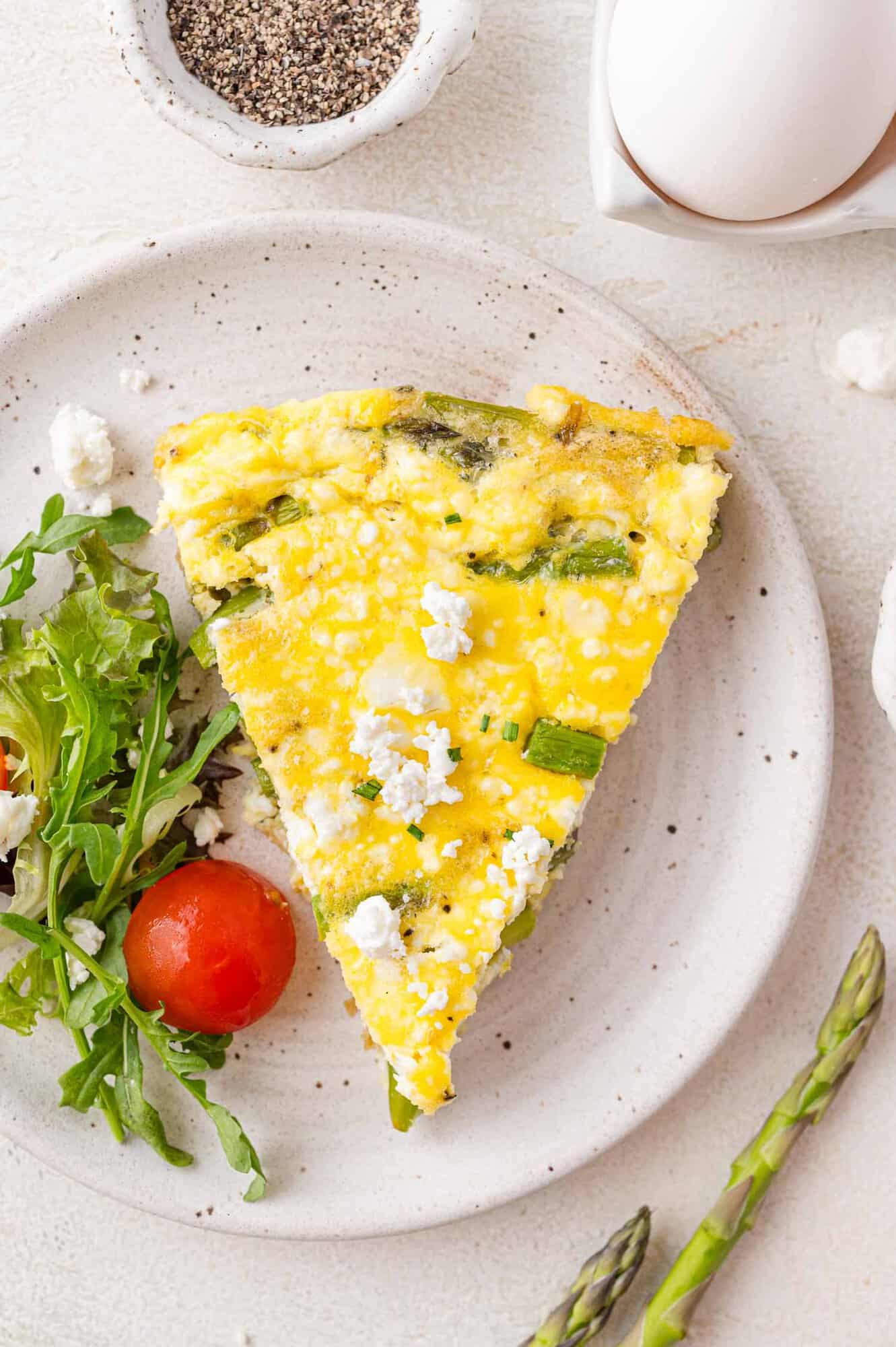Asparagus Frittata
Recipe Overview
Why you’ll love it: Asparagus frittata is a perfect brunch offering for everyone, including vegetarians. It’s light, fresh and delicious, but goat cheese adds just a bit of decadence!
How long it takes: 30 minutes
Equipment you’ll need: oven-safe skillet
Servings: 4 as a main dish (you can get a few more servings if you’re serving other dishes with it)
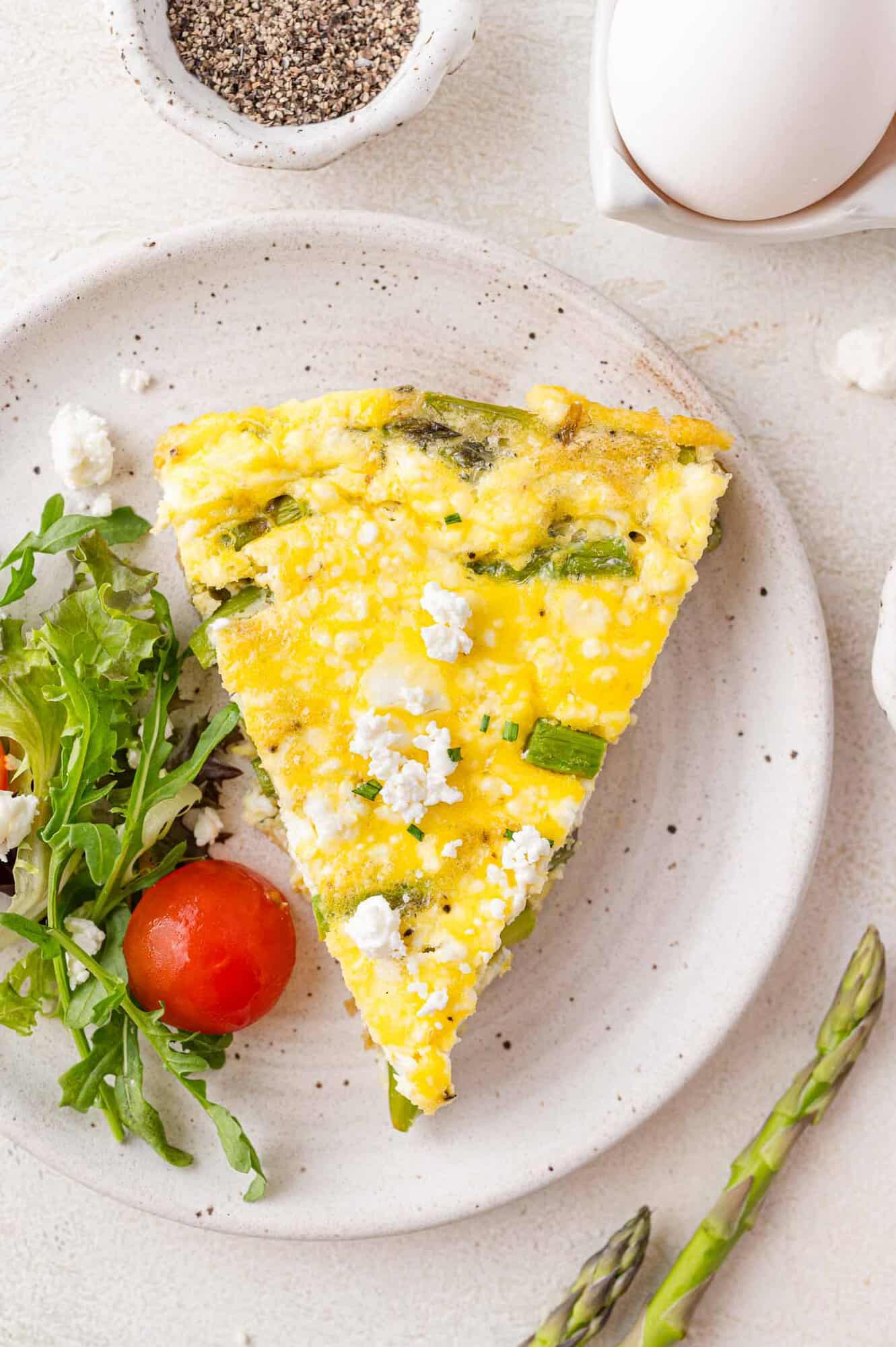
Pin this now to find it later
What brunch is complete without an egg dish of some sort? I always like to pair something savory with sweeter options like stuffed French toast, which means turning to recipes like this asparagus frittata and roasted broccoli quiche.
Although it’s made with goat cheese (YUM!), this asparagus frittata is still lighter than a quiche since it’s made without a crust. Quiches also tend to have more milk (or cream or half-and-half) to create more of a custard-like texture. In other words, frittatas are a lightened-up way to enjoy eggs for brunch!
Delicious Asparagus Frittata
Easier to make than quiche. Because a frittata doesn’t have a crust, there’s no need for fussy dough work or rolling—or stressing over torn dough and fluted edges that just don’t look quite right. (This crustless quiche is also stress-free!)
Easy to customize. This recipe can easily be adapted with different types of cheese based on what you like or what you have on hand. You can also reduce or replace the asparagus with another veggie like sautéed mushrooms or chopped tomatoes. Fresh herbs can be either mixed into the frittata itself, or added as a garnish.
Vegetarian-friendly. A lot of brunch egg bakes and casseroles are made with breakfast sausage, bacon, or ham, but this frittata is a great option for anyone who doesn’t eat meat. It’s so delicious that meat eaters will want a slice too!
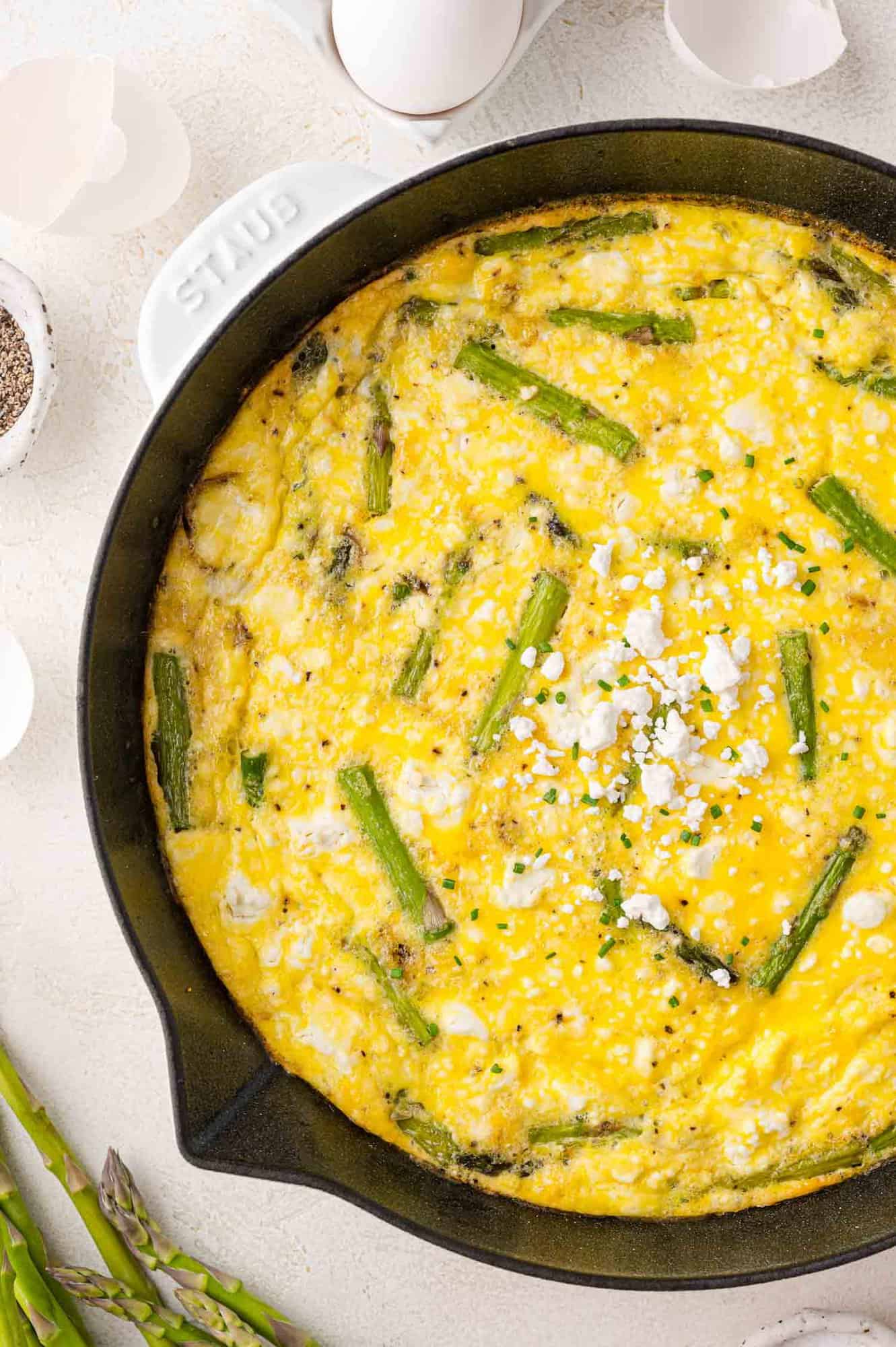
Ingredient Notes
- Unsalted butter and extra-virgin olive oil: Cooking the sliced shallots and asparagus in a combination of oil and butter adds extra richness to the flavor of this frittata.
- Shallots: In my original version of this asparagus frittata recipe, I used leeks. You can swap those in if you’d like, or if you can’t find shallots, use an equivalent amount of thinly sliced yellow cooking onion. Sliced green onions (both white and green parts) work well, too.
- Asparagus: Look for spears that are neither too thick nor too thin. The asparagus should be firm and crisp. It should snap cleanly when you bend it. Frozen or canned asparagus will not work well for this recipe.
- Eggs: Since a frittata is an egg dish, eggs are the main ingredient. You’ll need 8 large eggs. To avoid getting bits of shell in the frittata, I recommend cracking each egg individually into a small bowl, then transferring it to the larger bowl with the rest of the ingredients. This way, if you get a little shell in there, it’s easier to fish out.
- Milk: Any kind you keep on hand in the fridge will work. For the best tasting frittata, I recommend using whole milk.
- Goat cheese: I love goat cheese with asparagus for a springtime egg dish. Feel free to substitute another type of cheese you like or happen to have. Almost any cheese will pair well with asparagus.
- Fresh chives: Freshly snipped chives make a lovely garnish for this asparagus frittata, and chives are abundant in the spring. You could substitute fresh dill, if you like.

How to Make Asparagus Frittata
Preheat oven. Turn the oven on to preheat to 400ºF with the oven rack in the center of the oven. Preheating the oven is essential to the success of this recipe.
Soften the shallot. Warm the butter and olive oil in an oven-safe skillet (10 inch). Once the butter has melted, add the shallots and season with salt and pepper. Cook until they’re translucent, about 3 or 4 minutes. You don’t want the shallots to brown, just to soften a bit, and they’ll continue to cook with the asparagus.


Add the asparagus. Stir the chopped asparagus into the pan with the shallots. Cook, stirring frequently, until the asparagus is bright green and tender-crisp. Don’t let it get too soft because it will cook more in the oven.


Mix the eggs. Whisk the eggs, milk, salt, and pepper in a medium bowl until the yolks and whites are completely blended.
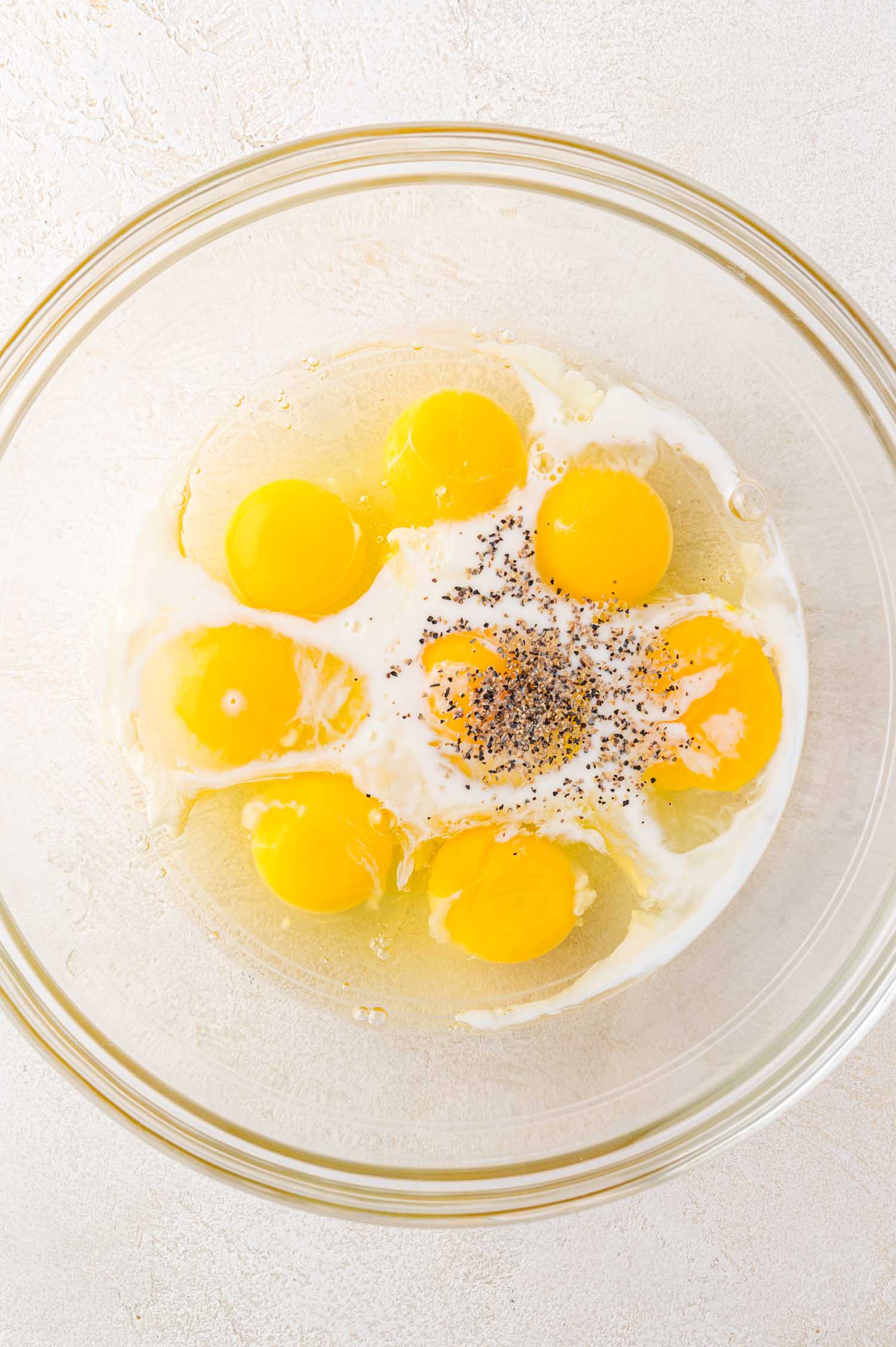
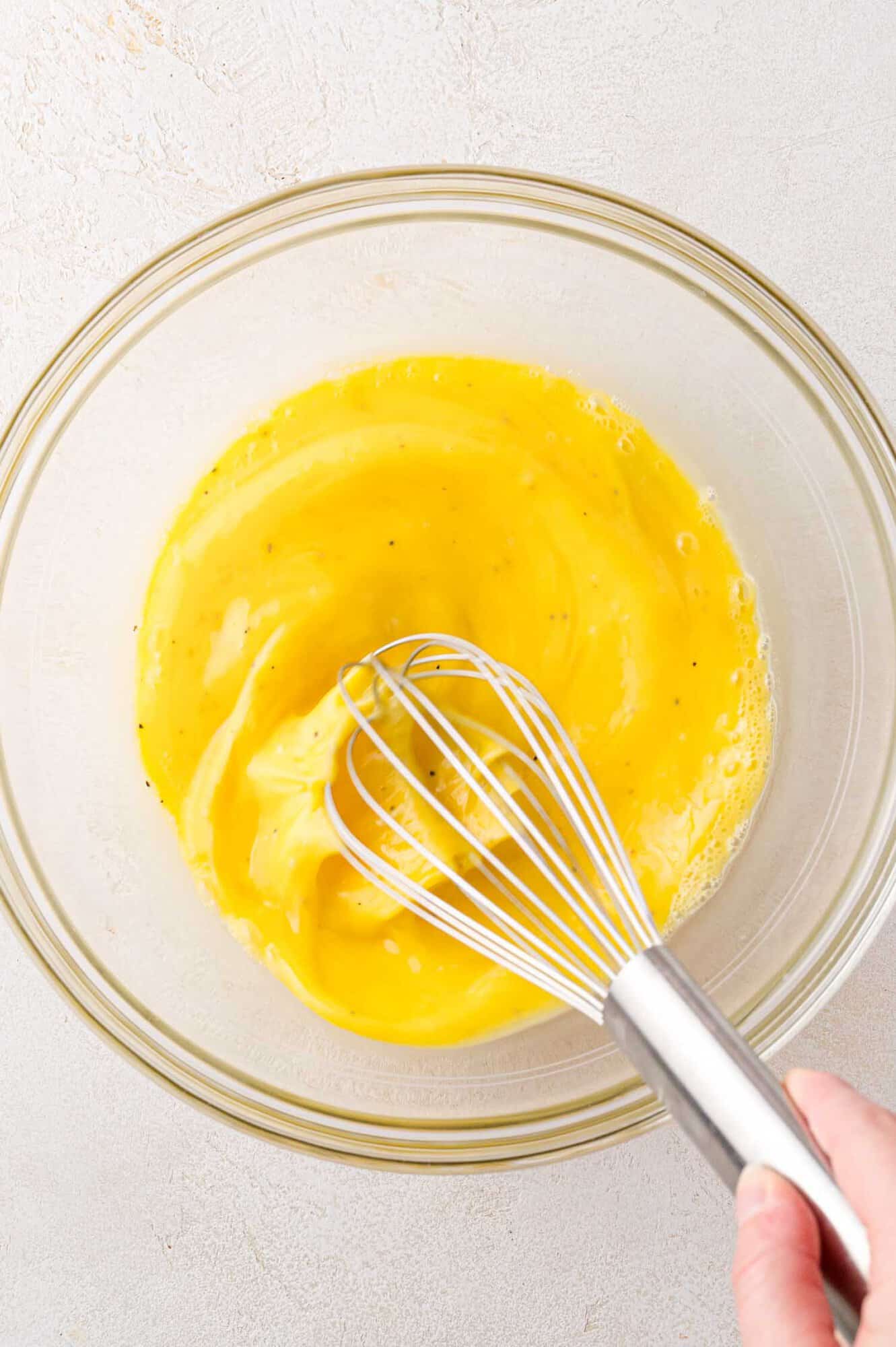
Assemble. Reduce the heat to low and pour the egg mixture into the pan with the vegetables. Stir gently and cook for a minute. The eggs should be starting to set but will not be cooked yet. Turn off the heat and crumble the goat cheese over the top of the eggs.


Bake. Immediately place the skillet in the preheated oven and bake until the eggs are set in the center. This should take about 10 minutes. Remember to use a hot pad when removing the pan from the oven because the handle will be very hot.
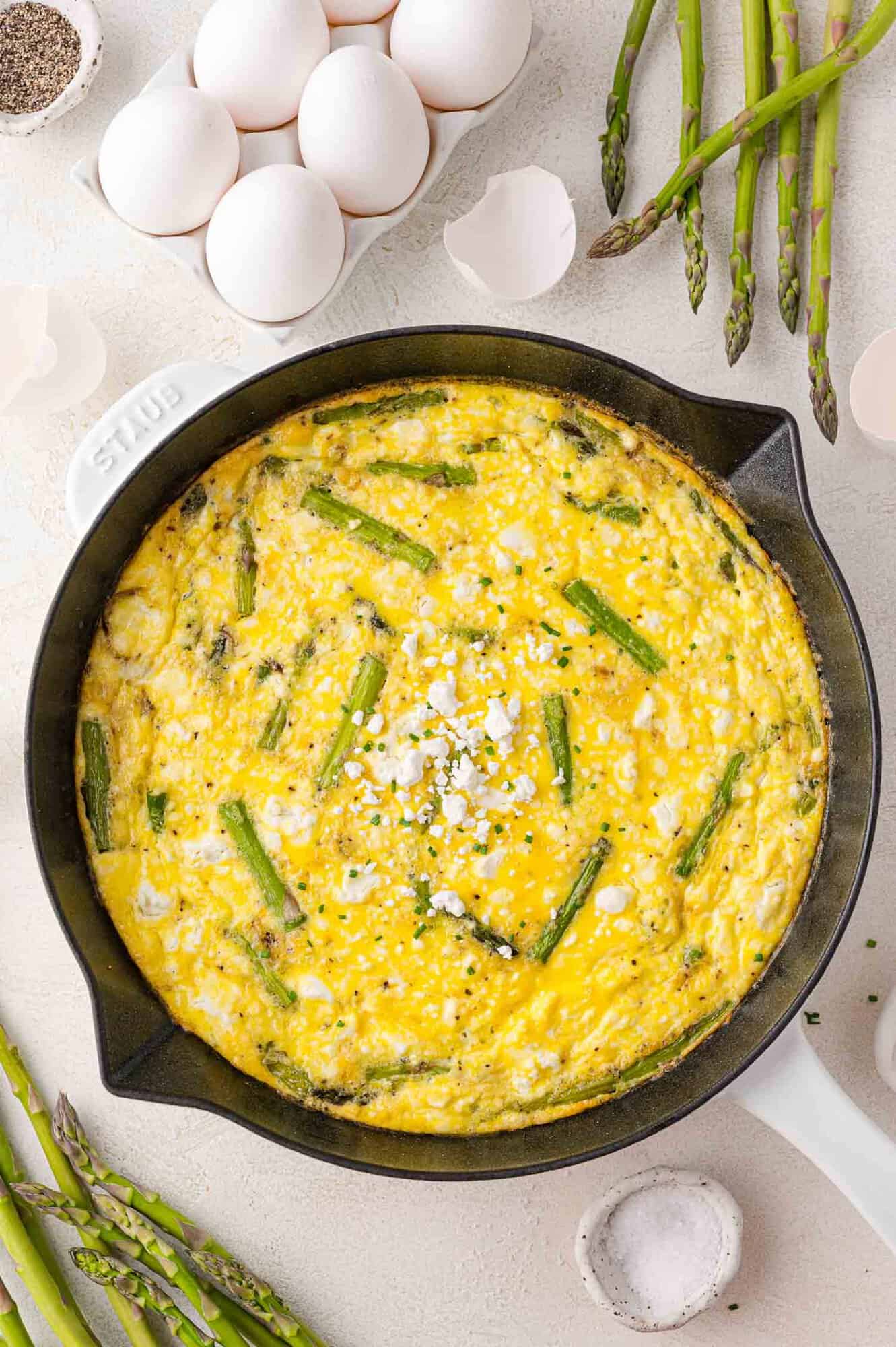

Serve. Cut the asparagus frittata into wedges to serve hot, room temperature, or chilled. If it’s puffy in spots after you take it out of the oven, it should deflate on its own as it cools, or you can poke it with a fork or knife to let the air out.
Tips and Variations
Avoid overcooking. It can be hard to tell when egg dishes are done. Remember it’s absolutely fine if the center of the frittata is still a little moist—this means your frittata will be tender and creamy. The frittata should be lightly browned on the edges and no longer wobbly in the middle. You can test the frittata by inserting a table knife in the center. If the knife comes out clean without runny egg clinging to it, the frittata is fully cooked.
Use fresh asparagus. Even the best frozen asparagus is much limper than fresh. I highly recommend using fresh asparagus for that nice tender-crisp texture.
Customize with leftovers. Leftover veggies are fantastic in a frittata! You’ll need to reduce the amount of asparagus to keep the proportions the same, or simply substitute another vegetable. Try this sautéed spinach or roasted radishes.
Serving Suggestions
Refrigerate: Leftover asparagus frittata can be stored in a covered container in the refrigerator for 3 to 4 days. It makes a fantastic easy breakfast or lunch.
Freeze: Frittatas can also be frozen! For quick weekday breakfasts, wrap individual slices in plastic wrap and place them in a freezer-safe bag or container. Freeze for up to 3 months and thaw in the refrigerator overnight before reheating.
Reheat: You can eat frittatas cold or at room temperature. To reheat, place a slice of frittata in a skillet over medium heat for a few minutes until warmed through, or heat it in the microwave for 30 seconds and then 10-second intervals until it’s warm.
Preheat oven to 400°F.
In an oven-safe 10 inch skillet, heat butter and olive oil over medium heat. Add shallots, season with ¼ teaspoon salt and ⅛ teaspoon pepper, and cook for 3 to 4 minutes, stirring occasionally, or until translucent.
1 tablespoon unsalted butter, 1 tablespoon extra virgin olive oil, ½ cup thinly sliced shallots
Add asparagus to the pan and cook for an additional 4 to 5 minutes or until the asparagus is bright green and tender, but still crisp.
8 oz. fresh asparagus spears, washed and cut into 1 ½ -inch pieces
Meanwhile, in a medium bowl, whisk together eggs, milk, and ¼ teaspoon salt and ⅛ teaspoon pepper.
8 large eggs, ¼ cup milk
Once asparagus is cooked, reduce heat to low, add egg mixture to the pan, and cook for 1 minute, stirring gently. Turn heat off; break apart goat cheese and distribute evenly over frittata.
4 oz. goat cheese
Transfer the skillet to preheated oven and bake for 10 minutes or until eggs are set.
Slice into 8 wedges to serve. Frittata may be served hot, room temperature, or even cold.
- Cheese: Another type of cheese can be substituted, such as feta, freshly shredded Parmesan, Swiss, or Gruyere.
- Yield: This recipe will serve 4 as a main course, or up to 8, if you’re serving the frittata with other entrées.
- Storage: Refrigerate leftover frittata in a covered container for 3 to 4 days. To freeze, wrap individual slices in plastic wrap and place them in a freezer-safe bag or container. Freeze for up to 3 months and thaw in the refrigerator overnight before reheating. Frittata can be served warm or at room temperature.
- Recipe retested and revised 2/2025. Previously posted as Asparagus and Leek Frittata. If you prefer, substitute leeks for the shallots.
Serving: 2wedges, Calories: 316kcal, Carbohydrates: 9g, Protein: 20g, Fat: 22g, Saturated Fat: 10g, Polyunsaturated Fat: 3g, Monounsaturated Fat: 8g, Trans Fat: 0.2g, Cholesterol: 394mg, Sodium: 548mg, Potassium: 384mg, Fiber: 2g, Sugar: 5g, Vitamin A: 1376IU, Vitamin C: 6mg, Calcium: 141mg, Iron: 4mg
Nutrition information is automatically calculated, so should only be used as an approximation.

